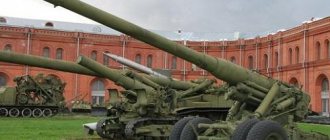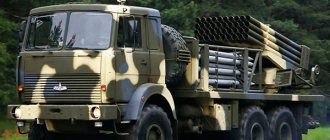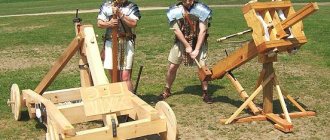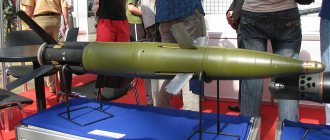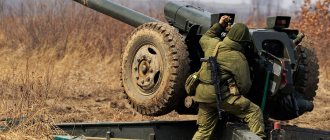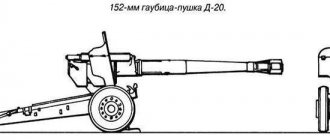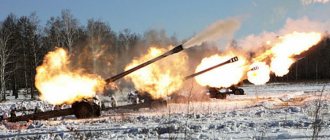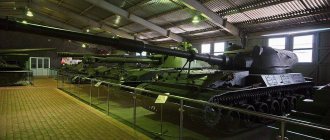Gun 2A36 Giatsint-B 152 mm. Firing range. Dimensions. Device
In connection with the gradual removal from service of the 130-mm M-46 field gun, the Soviet Army needed a new gun with a long firing range and capable of fighting enemy artillery. Two 152 mm artillery systems were created - the 2S5 self-propelled gun and the 2A36 towed gun, which used an almost identical barrel. In the Armed Forces of the CIS countries, the gun is designated "Hyacinth".
Gun 2A36 "Gyacinth-B" - video
Unlike previous Soviet-designed artillery systems, the 2A36 is a completely new design. The 49-caliber barrel is equipped with a multi-slit muzzle brake; double-frame carriage with pallet; the wheel travel is biaxial. In the combat position, the wheels are suspended using a hydraulic jack. Unusual for Soviet artillery systems is the hydraulically driven loader, which operates in combination with an automatic bolt with horizontal stroke. Such a system allows the 2A36 cannon to fire up to six rounds per minute; Thus, one battery of eight 2A36 guns is capable of raining down almost a ton of shells on a target in one minute. Like most Soviet guns, the 2A36 is equipped with a shield to protect the gun's various systems; in addition, there is a small shield above the recoil shock absorber.
The long barrel of the 2A36 cannon imparts a high initial velocity to the projectile, equal to approximately 800 m/s, which allows for a correspondingly long shot range of 27,000 meters when using standard ammunition. There is a report that when using an active-missile projectile, a firing range of 40,000 meters has been achieved. The 2A36 cannon fires cannon-loading ammunition with extended projectiles - this type of ammunition is used only by the 2S5 self-propelled gun; At one time, these included tactical nuclear shells. Other types include high-explosive fragmentation projectile (the most common, weighing 46 kg), concrete-piercing, incendiary and chemical (currently withdrawn from service). When firing directly at armored targets, an armor-piercing projectile is used.
152 mm towed howitzer Msta-B (2A65)
The 152-mm howitzer "Msta-B" (GRAU index - 2A65) can be considered the last in a long line of post-war field howitzers of Soviet design. At the same time, much less is known about it than about the 152-mm self-propelled howitzer 2S19 Msta-S; we can say that the towed version is in the shadow of the self-propelled gun. At the same time, both the 2S19 “Msta-S” (put into service in 1989) and the towed howitzer 2A65 “Msta-B” (put into service in 1986) were the most modern field artillery guns of the Soviet Army, and now the Russian one.
Both artillery systems are still in service and actively used. The artillery units of both systems (2A64 and 2A65, respectively) have the same design, the only difference is that the 2A64 has an ejector to remove powder gases from the barrel after firing. Serial production of the towed version began in 1987. Currently, the 152-mm Msta-B howitzer is in service with the Russian army, as well as a number of post-Soviet countries - Belarus, Kazakhstan, Georgia and Ukraine. Howitzers managed to fight during the second Chechen war, as well as the armed conflict in eastern Ukraine on the territory of Donbass. Artillery systems are also used in Iraq and were purchased from Russia by the government of the country to fight ISIS and in Syria.
Towed howitzer Msta-B
In the mid-1970s, the Soviet Union, almost simultaneously with NATO, realized the need for a radical modernization of artillery systems and a transition to a single caliber in the army and divisional levels of the ground forces. In the future, the place of guns of 120, 130, 152, 180 and 203 mm caliber was to be taken by a single 152 mm caliber artillery system of separate cartridge loading, developed in towed and self-propelled versions, with a unified set of ammunition used. The new Msta howitzer, which has been developed since 1976 under the leadership of chief designer G.I. Sergeev, was supposed to be such an artillery system. Work on the creation of a new artillery system was carried out at the Barrikady Design Bureau (today the Titan Design Bureau) in the city of Volgograd.
According to the technical specifications received from the military, the Msta howitzer was intended to destroy delivery vehicles for tactical nuclear charges, mortar, artillery and missile batteries, destroy field fortifications and other defensive structures, command posts and control posts, air and missile defense systems, tanks and other armored targets, manpower and enemy firepower. The firing range was supposed to impede the maneuvers of enemy reserves located in the depths of his defense. The howitzer was supposed to fire at both observed and unobserved targets from closed positions and direct fire, including operation in mountainous conditions. Despite the fact that the main goal of creating a new artillery system was superiority over foreign competitors, both existing and those just being developed, the ability to use the old standard rounds of towed howitzers D-20, ML-20, and self-propelled guns 2S3 with the artillery system was again a mandatory requirement. and 2S5, with variable charges in both steel and brass cases.
The R&D complex to create a new towed howitzer Msta-B began in 1976. The main goal of developing a new artillery system was: increasing the firing range, increasing the vertical guidance angle, increasing the effective action of the projectile at the target, maneuverability and other characteristics in comparison with the D-1, ML-20 and D-20 howitzers, which were in service with the Soviet Army .
The main attention during the development of the new howitzer was paid to the issue of ensuring high accuracy of fire through constructive measures. The layout of the main components of the 152-mm Msta-B howitzer was implemented taking into account the stability of disturbing moments arising during firing. Even at the stage of designing and testing the gun, the designers carried out a study to select the optimal combination of design and geometric parameters of the projectile, which ultimately made it possible to ensure improved aerodynamic characteristics of the new high-explosive fragmentation projectile, as well as its stability along the trajectory, despite the significant length and long-range shape of the projectile .
The Msta-B howitzer was equipped with a semi-automatic bolt, as well as spring-type rammers designed to ram the projectile and cartridge case, a hydraulic jack with a tray for firing with the wheels hanging, hydraulic recoil devices with liquid cooling of the recoil brake, a two-speed screw mechanism for horizontal guidance and a two-speed mechanism vertical guidance of a sector type, an aiming device designed for firing from closed positions and direct fire, a pneumatic wheel braking system, frames with folding bipods and undercarriage rollers.
Work on the creation of the howitzer was completed successfully; in 1986, the new artillery system was adopted by the Ground Forces of the USSR Armed Forces; serial production of towed howitzers began in 1987. The production of howitzers was carried out by the Perm Machine-Building Plant). In total, about 1,200 such howitzers were assembled in Perm. For the development of the 152-mm towed howitzer Msta-B, a large group of design engineers from the Barrikady Design Bureau were awarded various government awards, and the work itself on the design of the artillery system and the shots for it was awarded the USSR State Prize.
The following design solutions were successfully implemented in the 152-mm Msta-B howitzer: - a three-chamber muzzle brake, which had an efficiency of up to 63%; — a loading mechanism with a spring-loaded projectile rammer, cocked from the recoil parts, and a guide tray driven by the bolt; — two-speed gun barrel guidance mechanisms, which provided vertical guidance angles of up to 70 degrees and horizontal guidance on slopes of up to 5 degrees; — automatic shutdown of wheel suspension when the frames are extended.
The towed 152-mm howitzer Msta-B (2A65) was built according to the classic design for artillery guns. The howitzer received a monoblock barrel equipped with a three-chamber cast muzzle brake and a semi-automatic vertical wedge breech; the barrel length was 53 calibers. Hydropneumatic recoil devices (knurler and liquid-cooled recoil brake) were located above the barrel. To protect the crew (consisting of 8 people) and the howitzer mechanisms from small fragments and bullets, the howitzer had an upper machine with a shield cover. There were also rotary (two-speed, screw), lifting (two-speed, sector type) and balancing mechanisms.
The lower machine of the howitzer received two box-section frames and a two-wheeled chassis. A special pallet was installed on the lower machine of the howitzer carriage, onto which the gun was lowered using a hydraulic jack when transferring the artillery system from the traveling to the combat position. At the ends of the box-shaped frames, auxiliary metal rollers were placed, with the help of which the howitzer could be rotated to fire in any required position (without changing the position of the howitzer frames, the angle was 55 degrees). In the vertical plane, the existing lifting mechanism of the upper machine ensures that the 152-mm Msta-B howitzer is aimed at the target in the angle range from −3.5 to +70 degrees. To reduce the fatigue of the howitzer crew and increase the rate of fire, it was equipped with two spring-type throw-type rammers for delivering charges and projectiles.
When the howitzer is moved to the stowed position, the pallet is raised and attached to the barrel and cradle, and the frames are shifted and then connected to the towbar of the tractor. The standard means of transporting the artillery system is the Ural-4320 all-terrain army truck, which has a 6x6 wheel arrangement. The howitzer's sprung wheel travel ensures its towing on the highway at speeds of up to 80 km/h, and when driving over rough terrain - up to 20 km/h.
The ammunition load of the 152-mm towed howitzer Msta-B included several types of high-explosive fragmentation shells (including 3OF61 extended range, equipped with a bottom gas generator), radio jamming shells, cluster shells with high-explosive fragmentation and cumulative fragmentation submunitions, smoke target designator shells . Also, the howitzer can be used with 3OF39 adjustable artillery ammunition of the Krasnopol guided weapon complex with laser target illumination. A crew of three people can highlight a target using a laser target designator-rangefinder, which is part of the Malachite portable automated fire control system. Small targets such as a tank can be illuminated from a distance of up to 4 kilometers at night and 5-7 kilometers during the day, larger targets - up to 15 kilometers.
The maximum firing range of conventional high-explosive fragmentation projectiles is 24.7 kilometers, with a 3OF61 projectile with a bottom injection gas generator and a long-range charge - up to 30 kilometers. The howitzer can be used with all types of separately loaded rounds created for both the towed Msta-B and the 2S19 Msta-S self-propelled gun, as well as for earlier artillery systems of the same caliber - D-20 and ML-20 howitzers, 2S3 self-propelled guns " Acacia".
Tactical and technical characteristics of the Msta-B howitzer:
Caliber - 152 mm. Weight - 7000 kg. The maximum firing range is 24.7/30 km. Rate of fire - 7-8 rds/min. Ammunition - 60 rounds. Projectile weight - 43.56 kg. Elevation angle - from -3 to +70 degrees. The horizontal guidance angle is 55 degrees. The standard tractor is Ural-4320 or MT-LB. Transportation speed is up to 80 km/h (on the highway). Calculation - 8 people.
Sources of information: https://otvaga2004.ru/kaleydoskop/kaleydoskop-art/msta-po-uralski https://army-news.ru/2015/12/152-mm-buksiruemaya-gaubica-msta-b-2a65 https ://mz.perm.ru/products/21/479 https://www.russianarms.ru/forum/index.php?topic=3528.0 Materials from open sources
Modernization
2A36M "Dilemma-2A36"
Russian 152 mm modified towed gun.
The 2A36s in service today have been modernized and additionally equipped with:
— Rechargeable battery — NAP unit: satellite receiver, antenna unit — Self-orienting gyroscopic angle measuring system — Computer — mechanical speed sensor
2A43 "Gyacinth-BK"
Soviet experimental 152-mm towed gun. It features cap loading. Developed by OKB-9.
2A53 "Gyacinth-BK-1"
Soviet experimental 152-mm towed gun. It features cap loading. Developed in the design bureau of the Lenin Plant
2A53M "Gyacinth-BK-1M"
Modernized version of 2A53. Also developed in the design bureau of the Lenin Plant
Performance characteristics of 2A36 Giatsint-B
— Adopted: 1975 — Designer: Motovilikha Plants — Developed: from 1968 to 1975 — Manufacturer: Motovilikha Plants — Years of production: from 1975 to 1989 — Total produced: 2543
— Crew (crew), people: 8
Weight 2A36 Giatsint-B
— 9760 kg
Dimensions 2A36 Giatsint-B
— Length, mm: 12 300..12 920 — Barrel length, mm: 7562 — Width, mm: 2788 — Height, mm: 2760
— Caliber, mm: 152.4 — Shutter: wedge — Carriage: wheeled with sliding frames
— Elevation angle: -2.5..+57 — Rotation angle: -25..+25
Rate of fire 2A36 Giatsint-B
— 5..6 shots/min
Firing range 2A36 Giatsint-B
— Sighting range, m: 30,500 (OFS) — Maximum range, m: 40,000 (AR OFS)
— Initial projectile speed, m/s: 945 — Sight: PG-1M, OP4M-90A
— Type of tractor: KamAZ-63501AT — Ground clearance, mm: 475 — Transportation speed on the highway, km/h: 35..80.
152 mm howitzer gun mod. 1937 (ML-20)
ML-20 at Poznan Citadel, Poland.
ML-20 at the Hämeenlinna Artillery Museum, Finland.
ML-20 at the Hämeenlinna Artillery Museum, Finland.
ML-20 at the Batei HaOsef Museum, Israel.
Red Army
The ML-20 was originally intended for corps artillery. Together with the 122-mm A-19 gun, it formed the so-called “hull duplex”. In 1940-41 There were three types of corps artillery regiments:
- With two ML-20 battalions and one of the A-19 or 107 mm guns (24 ML-20 in total).
- With two ML-20 battalions and two A-19 or 107 mm guns (24 ML-20 in total).
- With three ML-20 divisions (36 ML-20 in total).
Soon after the start of Operation Barbarossa, the corps artillery was liquidated (as were the rifle corps themselves). It was restored later, during the war. The new corps artillery regiments were supposed to be armed with 122 mm guns or 152 mm howitzers, but some memoirs mention that ML-20s were also used.
Since 1943, the gun has been used in artillery regiments of armies. There were 18 such regiments ML-20. Since the beginning of 1945, the Guards armies had artillery brigades of 36 ML-20s.
ML-20s were also used by artillery regiments (24 units) and brigades (36 units) of the Reserve of the High Command.
It was mainly used for indirect fire against enemy personnel, fortifications and key objects in the near rear. The heavy fragments of the OF-540 HE-Fragmentation round were capable of penetrating armor up to 20–30 mm thick, making barrage dangerous for lightly armored vehicles and, to some extent, for heavier armored vehicles, since fragments could damage the chassis, sights or other elements ; sometimes a nearby explosion resulted in damage inside the vehicle, although the armor remained intact. A direct hit from a shell often resulted in the turret of a medium tank being torn off or jammed on a heavy tank. [ citation needed
]
The first combat use of the ML-20 was in the Battle of Khalkhin Gol in limited numbers. [3] He also saw action in the Winter War against the fortifications of the Mannerheim Line. The pistol continued to be used throughout World War II.
The excellent characteristics of the gun, including reliability and ease of maintenance, allowed it to remain in service with the Soviet Army for a long time after the war. [ citation needed
]
Other operators
Early in the German invasion of the Soviet Union, hundreds of ML-20s were captured by the Wehrmacht. The gun was adopted by the Germans as 15.2 cm KH.433/1(r)
. Since February 1943, the Germans have been producing ammunition for the gun.
The Finnish Army captured 37 guns of the type in 1941-44 and received an additional 27 from Germany. These guns were adopted as the 152 H 37
.
A number of barrels were connected to A-19 carriages and received 152 N 37-31
.
Although the gun was generally liked, the Finnish army did not have a sufficient number of tractors suitable for towing such a massive weapon. As a result, some of the guns were transferred to the coastal artillery. Two pieces were captured by the Red Army. Some of these guns were modernized in 1988 and, as of 2004, remain in reserve as 152 H 88-37
. [4] (all 152 H 88 series have been discontinued since 2007).
After the war, the ML-20 was widely exported to the Warsaw Pact allies, as well as to many states in Asia and Africa (the weapon still remains in service in some of these states). It was adopted by Egypt and Syria and participated in the Arab–Israeli conflict. In 2002, a television documentary was shown showing the ML-20 being used by Afghanistan's Northern Alliance forces against Taliban militants; It is likely that these weapons were originally supplied to the Najibullah regime.
Photo Giatsint-B
2A36 in tow behind the KamAZ-63501AT “Bear” tractor
Similar
SAU 2S7 Pion (2S7M Malka) performance characteristics.
Caliber. Dimensions. Firing range of MLRS BM-21 Grad. Damage area. Rockets. Caliber. Story
120-mm mortar 2B11 complex 2S12 Sani TTX. Firing range. Weight
Mortar 2B9M Vasilek 82 mm Rate of fire. Firing range. Weight
Self-propelled gun 2S3 Akatsiya 152 mm. Firing range. Dimensions. Weight. Engine
SAU 2S1 Gvozdika 122 mm Firing range. Dimensions. Device. Weight
Gun 2A36 Giatsint-B 152 mm. Firing range. Dimensions. Device
MLRS 9K58 Smerch Damage area. Rockets. Caliber. Story
MT-12 Rapier gun. Firing range. Story. Dimensions
Howitzer D-30 122-mm performance characteristics. Firing range. Dimensions. Weight
2S4 Tulip self-propelled mortar 240 mm performance characteristics. Dimensions. Firing range. Weight
Self-propelled gun 2S35 Koalitsiya-SV 152-mm performance characteristics. Firing range. Dimensions. Weight
Howitzer Msta-B (2A65) 152 mm. Firing range. Dimensions. Weight. Ammunition
Self-propelled gun 2S9 Nona-S 120 mm performance characteristics. Firing range. Dimensions. Weight. Armament
AT-T heavy artillery tractor. TTX. Dimensions. Engine. Story
SAU 2S19 Msta-S 152 mm Dimensions. Speed. Engine. Story
MLRS 9K57 Hurricane Damage area. Rockets. Caliber. Story
TOS-1 Buratino (TOS-1A Solntsepek) performance characteristics. Damage area
Divisional gun ZIS-3 76 mm. TTX. Firing range. Dimensions. Weight
Howitzer gun D-20 152 mm performance characteristics. Firing range. Dimensions. Weight
Howitzer M-30 model 1938 122-mm performance characteristics. Firing range. Dimensions. Weight
Self-propelled gun 2S5 Giatsint-S 152 mm performance characteristics. Firing range. Armament. Dimensions. Weight
Self-propelled gun Ferdinand (Elephant) performance characteristics. Reservation. Weight. Dimensions
Self-propelled gun SU-100. TTX. Armament. Dimensions. Shells. Weight. Speed
Self-propelled gun Sturmtiger caliber 380 mm. TTX. Armament. Shells. Reservation. Dimensions
203-mm howitzer B-4 model 1931 performance characteristics. Weight. Ammunition. Dimensions
Self-propelled gun SU-152 St. John's wort 152 mm performance characteristics. Shells. Firing range. Dimensions. Weight
Gun M-46 130-mm performance characteristics. Firing range. Dimensions. Weight
Demining installation UR-77 Meteorite TTX. Armament. Dimensions
MLRS 9K51M Tornado-G. Rockets. TTX. Firing range. Dimensions
SAU 2S31 Vienna 120 mm. Firing range. Story. Dimensions. Weight
German self-propelled gun StuG III. Modifications. Dimensions. Armament. Weight
Guided projectile Krasnopol. TTX. Firing range. Dimensions. Price
Mortar Karl 600 mm and 540 mm performance characteristics. Firing range. Weight. Dimensions
Big Bertha 420 mm gun. TTX. Weight. Dimensions. Ammunition
Self-propelled gun SU-76. TTX. Dimensions. Reservation. Weight. Story
SAU 2S23 Nona-SVK 120-mm performance characteristics. Armament. Range and accuracy of fire. Dimensions
SAU 2A3 Condenser-2P caliber 406 mm Firing range. Armament. Dimensions. Weight
Mortar M-160 caliber 160-mm performance characteristics. Firing range. Ammunition. Dimensions
Airborne self-propelled gun ASU-57. Armament. TTX. Dimensions. Weight. Booking
Artillery complex A-222 Bereg 130 mm. TTX. Firing range. Ammunition
Howitzer BR-18 caliber 305 mm TTX. Firing range. Weight
152 mm howitzer D-1. Firing range. Dimensions. Weight. Device
Mortar M-240 caliber 240 mm. Firing range. Dimensions. Weight
Self-propelled gun SU-85. Ammunition. Reservation. Dimensions. Weight. Engine
Counter-battery radar Zoo-1 (1L219M). Range of control of firing positions. Device
SAU 2S25 Sprut-SD. Caliber. Story. Dimensions. Weight. Engine
Self-propelled gun 2S34 Hosta 120 mm. TTX. Dimensions. Firing range. Armament. Weight
Self-propelled gun ASU-85. Armament. Dimensions. Reservation. Weight
280-mm mortar Br-5 model 1939 Dimensions. Weight. Ammunition
Self-propelled gun 2A45M Sprut-B. TTX. Speed. Engine. Weight
Belarusian MLRS BelGrad. TTX. Firing range. Ammunition. Dimensions
S-23 cannon 180 mm caliber. Ammunition. Weight. Dimensions. Firing range
Self-propelled gun SAU SU-122. Dimensions. Armament. Reservation. Weight
Self-propelled gun Jagdpanther. Weight. Reservation. Dimensions. Armament
Multi-barreled self-propelled gun M50 Ontos. TTX. Armament. Dimensions. Booking
D-74 cannon 122 mm caliber. Firing range. Dimensions. Weight
Artillery tractor YA-12. Dimensions. Weight. Load capacity. Engine
Artillery tractor T-20 Komsomolets. Armament. Reservation. Dimensions. Weight
SAU ISU-122. Armament. Dimensions. Weight. Booking
RPU-14 (8U38) - rocket launcher
MLRS BM-24 (T) 240 mm. Firing range. Dimensions. Weight. Engine
2K32 Deva - 82-mm self-propelled mortar system
Artillery tractor Comintern. Load capacity. Dimensions. Weight. Engine
Self-propelled gun SU-122-54. Reservation. Dimensions. Weight. Firing range
MLRS BM-14-16. Armament. Dimensions. Weight. Firing range
Self-propelled gun Nashorn (Rhinoceros). Armament. Dimensions. Weight. Booking
BR-2 gun caliber 152 mm. Firing range. Dimensions. Weight
Self-propelled howitzer self-propelled gun PzH 2000. Firing range. Dimensions. Weight
BR-17 cannon 210 mm caliber. Weight. Firing range. Rate of fire
Self-propelled gun Vespe 105 mm. Armament. Dimensions. Reservation. Weight
Wheeled self-propelled gun GAZ-68 (KSP-76). Armament. Dimensions. Weight. Engine
Self-propelled gun Brummbar 150 mm. Armament. Dimensions. Weight. Booking
Heavy self-propelled gun SU-14. Reservation. Dimensions. Weight. Engine
Self-propelled gun SU-5. Armament. Reservation. Dimensions. Weight
Self-propelled gun AT-1. Reservation. Dimensions. Weight. Engine
Self-propelled gun SU-12. Armament. Reservation. Dimensions. Weight
152-mm gun-howitzer D-20 (52-P-546)
The 152-mm howitzer D-20 was designed at the Yekaterinburg OKB-9 under the leadership of Petrov. Serial production began in 1955 at plant No. 221 in Volgograd (now FSUE Barrikady). The D-20 howitzer has a barrel, the length of which is about 26 calibers, consisting of a monoblock pipe, a breech, a clutch and a two-chamber muzzle brake. Wedge shutter, vertical with mechanical semi-automatic. The rotating and lifting mechanism provides vertical firing angles of -5; +45 degrees, horizontal firing angle – 58 degrees.
To fire from the D-20, the same shots are used as for the 152-mm howitzer D-1. It is possible to fire tactical nuclear ammunition and Krasnopol guided missiles.
JSC Motovilikhinskiye Motovilikhinskiye Plants produced and tested by fire the modernization of the D-20, which increases the performance characteristics of the jacks and the reliability of the mechanisms of the bolt group systems.
The 152mm D-20 gun-howitzer is another example of the old Soviet tradition of combining components from existing artillery pieces. systems, receiving new ones. In this case, a new 152-mm barrel was installed on the carriage of a 122-mm D-74 field gun. This 152-mm howitzer was developed after the end of the Second World War (1941–1945), but industrial production of the howitzer gun began only in the early 1950s, and the gun was first shown in 1955.
The base of the D-20 is similar to the early model of the 152-mm howitzer D-1, but it has a different arrangement of recoil shock absorbers, and the weight of the D-74 carriage is such that additional wheels are required to move the howitzer gun on the front of the frame. The shape of the shield is also different.
However, the main difference between the D-20 and the D-1 is the choice of ammunition. When firing the D-20, most types of ammunition of the D-1 howitzer can be used, but it has its own family of ammunition. The D-20 gun became the first Soviet artillery system capable of firing tactical nuclear weapons. In addition, there was a large selection of chemically charged ammunition, which has now been withdrawn from service. An improved system of variable-power propelling charges made it possible to increase the maximum range to 17,410 meters, and the use of an active-missile projectile makes it possible to destroy targets at a range of up to 24 thousand meters. The latest innovations include the use of a 50-kilogram anti-tank projectile guided by a Krasnopol laser beam.
Armor penetration of the BR-540B armor-piercing blunt-headed tracer projectile (special charge, initial speed 600 meters per second, DBR fuse, direct shot range at a target height of 2.7 meters - 860 meters). The thickness of pierced armor at a meeting angle of 90 degrees at a distance of 500 meters is 130 mm, 1000 m is 120 mm, 1500 m is 115 mm, 2000 m is 105 mm. The thickness of pierced armor at a meeting angle of 30 degrees at a distance of 500 meters is 105 mm, 1000 m is 100 mm, 1500 m is 95 mm, 2000 m is 85 mm.
The 155 mm barrel, which is installed on the 2S5 self-propelled howitzer, is a modified D-20 barrel. The former Yugoslavia exported a modification of the D-20 with a 39-caliber barrel, which was adopted by the Yugoslav army - the state of affairs is unknown today. The Romanian Army is armed with a towed howitzer developed in Romania and known as the Model M1985. Its design shows some features of the D-20 howitzer gun. The Chinese modification was produced under the designation 152 mm Type 66.
Tactical and technical data of the 152-mm howitzer gun D-20:
First prototype - late 1940s; Serial production began in 1954 or 1955; In service: Algeria, Afghanistan, Hungary, Egypt, India, China, Nicaragua, CIS countries, Ethiopia, etc.; Combat crew – 10 people; Full combat weight - 5650 kg; Barrel length – 8690 mm; Total length in stowed position – 75580 mm; Width in stowed position – 2320 mm; Maximum fire range 17410 m; The maximum range of ARS fire is 24 thousand m; Initial projectile speed – 655 m/s; OFS projectile weight – 43.51 kg; Maximum elevation/declination angle +63/-5 degrees; The horizontal guidance angle is 58 degrees.
Tactical and technical characteristics of the 152-mm howitzer gun D-20:
Ballistic data: Initial speed of a high-explosive fragmentation projectile: - full charge - 655 m/s; - reduced charge - 511 m/s; The initial speed of an armor-piercing tracer projectile is 600 m/s; The initial speed of the cumulative projectile is 680 m/s; The longest fire range is 17410 m; Maximum pressure of powder gases – 2350 kgf/cm3; Weight of high-explosive fragmentation projectile - 43.56 kg; The mass of the armor-piercing tracer projectile is 48.96 kg; Weight of an armor-piercing tracer sharp-headed projectile - 48.78 kg; The mass of the cumulative projectile is 27.439 kg.
Design data of the 152 mm D-20 howitzer gun: Caliber - 152 mm; Barrel length including muzzle brake - 5195 millimeters; The length of the threaded part is 3467 millimeters; Number of grooves - 48; The width of the rifling is 6.97 millimeters; The steepness of the rifling is 25 klb.; The depth of the rifling is 3 millimeters; Field width – 3 millimeters; The length of the charging chamber from the beginning of the rifling to the breech end of the pipe is 772.9 millimeters; The greatest declination angle is -5°; The greatest elevation angle is 45°; Horizontal fire - 58°; The amount of steel in the knurl is 13.4 liters; The amount of steel in the rollback brake is 14.7 liters; The initial pressure in the knurl is 63 kgf/cm2; The maximum rollback length is 950 millimeters; Normal rollback length is 910 +20/-120 millimeters; Pressure in the balancing mechanism (elevation angle 45°) – 62 kgf/cm2; The pressure in pneumatic tires is 5.6 kgf/cm2.
Dimensional data of the 152-mm howitzer gun D-20:
Parameters of the gun in the stowed position: Length – 8690 millimeters; Width – 2317 millimeters; Height – 2520 millimeters; Parameters of the gun in firing position with a barrel elevation angle of 0°: Height - 1925 millimeters; Length – 8100 millimeters; The height of the firing line is 1220 millimeters; Ground clearance – 380 millimeters; Track width - 2000 millimeters; Wheel diameter - 1167 millimeters; Wheel tire width – 337 millimeters; The distance from the center of gravity of the gun to the axis of the wheels when mounted in a stowed position is 182 mm; Weight: - gun in stowed position - 5700 kg; - guns in firing position - 5650 kg; - shutter - 96 kg; - barrel with bolt - 2556 kg; — sliding parts – 2720 kg; — swinging part — 3086 kg; — cradles – 280 kg; - recoil brakes without barrel - 85.4 kg; - recoil brakes with barrel - 101.6 kg; - knurling without barrel - 88.6 kg; - knurling with barrel - 103.3 kg; — upper machine — 208 kg; — balancing mechanism — 58 kg.
Operational data of the 152 mm D-20 howitzer gun:
The transfer time between traveling and combat positions and back is from 2 to 2.5 minutes; Target rate of fire is about 6 rounds per minute; Transportation speed: — off-road — 15 km/h; — on cobblestone roads – 30 km/h; - on good roads - 60 km/h.

